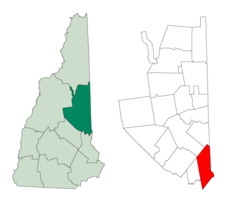Wakefield, NH
| Wakefield, New Hampshire | |
|---|---|
| Town | |

Town Hall
|
|
 Location in Carroll County, New Hampshire |
|
| Coordinates: 43°34′06″N 71°01′47″W / 43.56833°N 71.02972°WCoordinates: 43°34′06″N 71°01′47″W / 43.56833°N 71.02972°W | |
| Country | United States |
| State | New Hampshire |
| County | Carroll |
| Incorporated | 1774 |
| Government | |
| • Board of Selectmen | Connie Twombley Lino Avellani Charlie Edwards |
| • Town Administrator | Kelley Collins |
| Area | |
| • Total | 44.7 sq mi (115.8 km2) |
| • Land | 39.5 sq mi (102.2 km2) |
| • Water | 5.3 sq mi (13.6 km2) 11.72% |
| Elevation | 680 ft (207 m) |
| Population (2010) | |
| • Total | 5,078 |
| • Density | 110/sq mi (44/km2) |
| Time zone | Eastern (UTC-5) |
| • Summer (DST) | Eastern (UTC-4) |
| ZIP code | 03872 |
| Area code(s) | 603 |
| FIPS code | 33-78180 |
| GNIS feature ID | 0873743 |
| Website | www |
Wakefield is a town in Carroll County, New Hampshire, United States. The population was 5,078 at the 2010 census. The town includes the villages of Wakefield Corner (the original town center), East Wakefield, North Wakefield, Sanbornville, Union, Woodman and Province Lake. Wakefield Corner, popular with tourists, is a picturesque hilltop village of antique buildings. The state of Maine is on the eastern border of Wakefield.
Initially a native settlement, Wakefield was attacked by John Lovewell during Father Rale's War. Settled later by colonists from Dover and Somersworth, the town was granted in 1749 by John Mason. It was called East Town before being incorporated as Wakefield in 1774 by Governor John Wentworth. Wakefield, in Yorkshire, England, is near Wentworth Castle, the home of the Wentworth ancestors. It developed as an important sledge and stage stop between the seacoast and the White Mountains. The Wakefield Inn, built in 1804 beside the principal trade route through Wakefield Corner, remains operating today.
Although the soil was considered "stubborn," farmers made it productive. Lumber became a chief product, and by 1859 there were five sawmills, five gristmills, and ten shingle, clapboard and planing mills. Shoemaking was another local industry. When the Portsmouth, Great Falls and Conway Railroad arrived in 1871, the center of Wakefield shifted from Wakefield Corner to Sanbornville, which today remains the retail district of town.
...
Wikipedia
